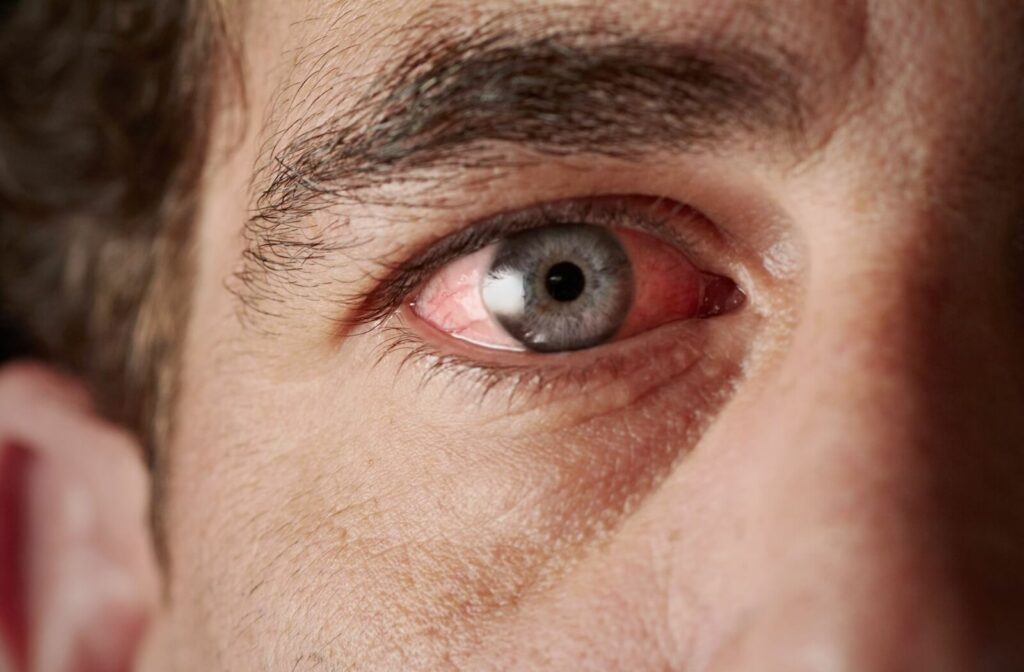Red, itchy, watery eyes—sound familiar? Many instantly think of pink eye (medically known as conjunctivitis)–a term that often stirs concern because it’s uncomfortable, inconvenient, and highly contagious. But what if the redness and irritation aren’t caused by pink eye? Many eye conditions share similar symptoms, including dry eye syndrome, allergies, blepharitis, or styes. Mistaking another issue for conjunctivitis could delay proper treatment and prolong discomfort.
Whether you’re a parent concerned about your child’s health or curious about eye conditions, practicing proper eye hygiene and consulting your optometrist when necessary can help keep your eyes healthy.
What Is Pink Eye (Conjunctivitis)?
Pink eye is an inflammation of the thin, transparent tissue lining the eyelid and eyeball. It’s one of the most commonly reported eye conditions affecting adults and children. While relatively straightforward to diagnose, it’s essential to understand its symptoms, causes, and contagiousness.
Symptoms of Pink Eye
Pink eye typically presents with:
- Redness in the white of the eye or inner eyelid
- Increased tearing or watery discharge
- A gritty feeling or mild sensitivity to light
- Yellow or green discharge, causing crusty eyelids (primarily upon waking)
- Itchiness and swelling around the eyes
If the symptoms are particularly severe or persistent, it’s always a good idea to consult a healthcare provider.
Causes of Pink Eye
Conjunctivitis generally falls into three main categories based on its cause:
- Viral: Highly contagious and often accompanied by cold or flu symptoms.
- Bacterial: Can spread via direct contact with contaminated surfaces or hands; often includes sticky, greenish discharge.
- Allergic: Triggered by allergens like pollen, dust, or pet dander; usually affects both eyes and doesn’t spread between people.
How Long Does Pink Eye Last?
With proper care, most cases of conjunctivitis can be resolved within a week or two. Viral infections often improve within 7 to 10 days without medication, while bacterial conjunctivitis might require antibiotics to speed healing. Allergic conjunctivitis, however, remains as long as you’re exposed to the allergen.
Is Pink Eye Contagious?
Viral and bacterial forms are contagious, making good hygiene critical in preventing the spread. However, allergic conjunctivitis is not infectious, as it is caused by environmental triggers rather than an infection.
What Else Could Be Mistaken for Conjunctivitis?
While pink eye is common, several other conditions share similar symptoms, raising the risk of misdiagnosis. Could something else be causing your red, irritated eyes? Let’s explore some possibilities.
Allergies

If your eyes are red, itchy, and watery, seasonal or environmental allergies could be the culprit. Unlike bacterial or viral conjunctivitis, allergies often affect both eyes symmetrically and are accompanied by sneezing or nasal congestion. Antihistamine eye drops or allergy medication can bring relief, but avoiding exposure to allergens is key.
Dry Eye Syndrome
Dry eye syndrome occurs when your eyes don’t produce enough tears or the tears evaporate too quickly. Symptoms like redness, a gritty sensation, and blurred vision are easily confused with pink eye. However, dry eye is generally chronic and may require treatments like artificial tears or, in severe cases, prescribed medications.
Contact Lens Irritation
If you wear contact lenses, redness could stem from overuse, improper hygiene, or an allergic reaction to the lens material or solution. Removing the lenses typically alleviates symptoms, but pink eye might persist.
Stye
A stye is a red, painful bump along the edge of the eyelid, often caused by a blocked oil gland. While it can cause swelling and redness around the eyes, unlike pink eye, it doesn’t affect the eyeball.
Blepharitis
Blepharitis, or inflammation of the eyelids, can mimic some symptoms of conjunctivitis, including redness and crusting. However, blepharitis is often recurring and linked to chronic conditions like rosacea. Warm compresses and lid hygiene can help reduce flare-ups.
When Red Eyes Signal Serious Eye Problems
Though many causes of red eyes are benign, some serious ones can masquerade as routine pink eye. Knowing the warning signs could save your vision.
Angle-Closure Glaucoma
This is a medical emergency where the pressure inside the eye rises rapidly, causing severe redness, eye pain, blurred vision, and nausea. If you experience these symptoms, seek urgent medical attention.
Iritis
Iritis, or inflammation of the iris, usually causes redness around the colored part of your eye, along with light sensitivity and eye pain. Unlike conjunctivitis, iritis often has no discharge and needs prescription medication to resolve.
Keratitis
Keratitis is an inflammation of the cornea, frequently caused by infection or injury. It can lead to redness, tearing, and sensitivity to light, but delayed treatment may result in permanent damage. Contact lens users are especially at risk, so never hesitate to consult your eye doctor if you suspect keratitis.
Prevention Tips for Pink Eye
Preventing pink eye starts with awareness and hygiene. Follow these simple tips:
- Wash your hands frequently and avoid touching your eyes.
- Disinfect surfaces like countertops, faucets, and doorknobs.
- Avoid sharing personal items like towels or makeup.
- Clean and replace contact lenses as instructed by your eye care provider.
- Use protective eyewear in dusty or high-pollution environments.
When to See a Doctor
If you’re uncertain about dealing with pink eye or another condition, seek medical advice. Contact an eye care professional if you experience:
- Severe pain in the eyes
- Vision changes, such as blurred or loss of vision
- Symptoms that worsen despite home treatment
- Sensitivity to light that persists
- Persistent redness lasting more than two weeks
Proper treatment can prevent complications and ensure your eyes remain healthy and comfortable.
Verona Vision Care knows from experience that conjunctivitis is a common but not always correct treatment for red and irritated eyes. Understanding its symptoms and distinguishing it from other conditions like allergies, dry eye, or even serious issues like glaucoma ensures you take the best action. Contact us today for more practical advice on protecting your eye health.




